Genetic Testing in CYLD Cutaneous Syndrome: An Update
- PMID: 34744449
- PMCID: PMC8566010
- DOI: 10.2147/TACG.S288274
Genetic Testing in CYLD Cutaneous Syndrome: An Update
Abstract
CYLD cutaneous syndrome (CCS) is an inclusive label for the inherited skin adnexal tumour syndromes Brooke-Spiegler Syndrome (BSS-OMIM 605041), familial cylindromatosis (FC - OMIM 132700) and multiple familial trichoepitheliomas (MFT-OMIM 601606). All three syndromes arise due to germline pathogenic variants in CYLD, a tumour suppressor gene (OMIM 605018). CCS is transmitted in an autosomal dominant pattern, and has variable expressivity, both of the three syndromic phenotypes, and of the severity of tumour burden. Age-related penetrance figures are not precisely reported. The first tumours typically appear during puberty and progressively accumulate through adulthood. Penetrance is typically high, with equal numbers of males and females affected. Genetic testing is important for confirmation of the clinical diagnosis, genetic counselling and family planning, including preimplantation diagnosis. Additionally, identified CCS patients may be eligible for future clinical trials of non-surgical pre-emptive interventions that aim to prevent tumour growth. In this update, we review the clinical presentations of germline and mosaic CCS. An overview of the germline pathogenic variant spectrum of patients with CCS reveals more than 100 single nucleotide variants and small insertions and deletions in coding exons, most frequently resulting in predicted truncation. In addition, a minority of patients have large deletions involving the CYLD gene, intronic pathogenic variants that affect splicing, or inversions. We discuss germline and somatic testing approaches. Somatic testing of tumour tissue, relevant in mosaic CCS, can reveal recurrently detected pathogenic variants when two or more tumours are tested. This can influence genetic testing of children, who may inherit this as a germline variant, and inform genetic counselling and prenatal diagnosis. Finally, we discuss testing technologies that are currently used, their benefits and limitations, and future directions for genetic testing in CCS.
Keywords: CYLD gene testing.
© 2021 Nagy et al.
Conflict of interest statement
The authors declare no conflicts of interest in this work.
Figures
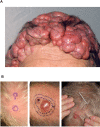
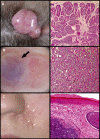

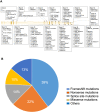
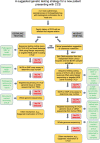
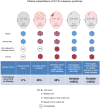
Similar articles
-
CYLD GeneticTesting for Brooke-Spiegler Syndrome, Familial Cylindromatosis and Multiple Familial Trichoepitheliomas.PLoS Curr. 2015 Feb 19;7:ecurrents.eogt.45c4e63dd43d62e12228cc5264d6a0db. doi: 10.1371/currents.eogt.45c4e63dd43d62e12228cc5264d6a0db. PLoS Curr. 2015. PMID: 25737804 Free PMC article.
-
Novel and recurrent germline and somatic mutations in a cohort of 67 patients from 48 families with Brooke-Spiegler syndrome including the phenotypic variant of multiple familial trichoepitheliomas and correlation with the histopathologic findings in 379 biopsy specimens.Am J Dermatopathol. 2013 Feb;35(1):34-44. doi: 10.1097/DAD.0b013e31824e7658. Am J Dermatopathol. 2013. PMID: 23249834
-
Multiple (familial) trichoepitheliomas: a clinicopathological and molecular biological study, including CYLD and PTCH gene analysis, of a series of 16 patients.Am J Dermatopathol. 2011 May;33(3):251-65. doi: 10.1097/DAD.0b013e3181f7d373. Am J Dermatopathol. 2011. PMID: 21389835
-
Phenotype-genotype correlations for clinical variants caused by CYLD mutations.Eur J Med Genet. 2015 May;58(5):271-8. doi: 10.1016/j.ejmg.2015.02.010. Epub 2015 Mar 14. Eur J Med Genet. 2015. PMID: 25782638 Review.
-
Brooke-Spiegler Syndrome and Phenotypic Variants: An Update.Head Neck Pathol. 2016 Jun;10(2):125-30. doi: 10.1007/s12105-016-0705-x. Epub 2016 Mar 14. Head Neck Pathol. 2016. PMID: 26971504 Free PMC article. Review.
Cited by
-
Dermoscopic Patterns of Genodermatoses: A Comprehensive Analysis.Biomedicines. 2023 Oct 6;11(10):2717. doi: 10.3390/biomedicines11102717. Biomedicines. 2023. PMID: 37893091 Free PMC article. Review.
-
CYLD alleviates NLRP3 inflammasome-mediated pyroptosis in osteoporosis by deubiquitinating WNK1.J Orthop Surg Res. 2024 Apr 1;19(1):212. doi: 10.1186/s13018-024-04675-2. J Orthop Surg Res. 2024. PMID: 38561786 Free PMC article.
-
Case report: Multiple facial trichoepitheliomas caused by p.Val835SerfsTer52 variant of CYLD gene.Front Med (Lausanne). 2024 Sep 30;11:1458723. doi: 10.3389/fmed.2024.1458723. eCollection 2024. Front Med (Lausanne). 2024. PMID: 39403278 Free PMC article.
-
Case report of syndromic multiple spiradenomas due to biallelic functional loss of CYLD.JAAD Case Rep. 2022 Jan 20;21:106-108. doi: 10.1016/j.jdcr.2022.01.002. eCollection 2022 Mar. JAAD Case Rep. 2022. PMID: 35198713 Free PMC article. No abstract available.
-
Novel CYLD pathogenic variant associated with multiple cylindromas of the scalp-A case report.Skin Health Dis. 2024 Aug 10;4(5):e436. doi: 10.1002/ski2.436. eCollection 2024 Oct. Skin Health Dis. 2024. PMID: 39355720 Free PMC article.
References
Publication types
LinkOut - more resources
Full Text Sources

